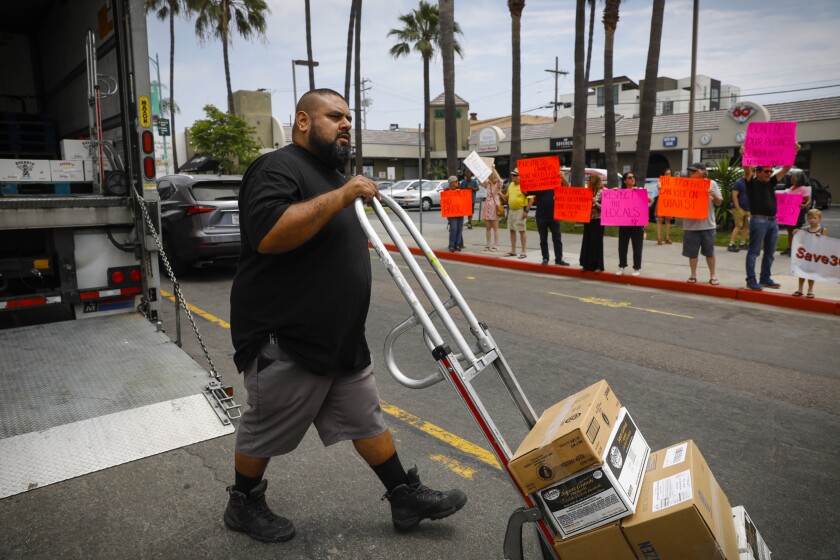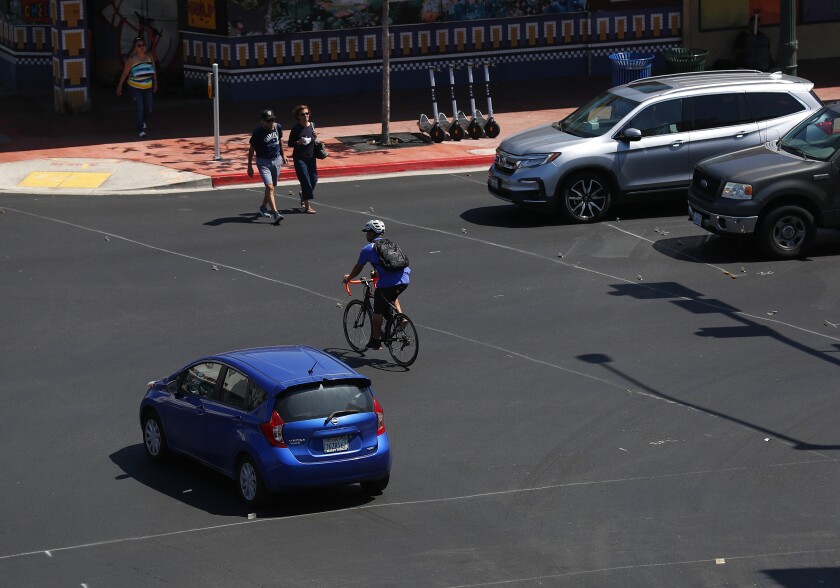Next week, construction crews will begin striping the road along 30th Street in North Park for the city’s newest protected bikeway project.
Known as the 30th Street Protected Bikeways Mobility Project, it calls for protected bike lanes from Juniper Street to Adams Avenue. It does away with some 450 curb parking spots along the corridor, but it incorporates “floating” parking, commercial loading zones, timed parking and accessible spots from Upas Street to Adams Avenue. Floating parking are spots that are not next to a curb but are a few feet away and are marked with striping on the road.
Transportation, cycling and environmental advocates have expressed support for the project in hopes that it will create a safer environment for people who bike along the popular corridor.
But some residents and businesses owners have repeatedly spoken against the project because of the reduced number of parking spaces in the area. Disability advocates have also shared concerns about fewer accessible parking spots.
The San Diego Union-Tribune spoke with Everett Hauser, program manager with the city’s Transportation Department, about what North Park residents can expect to see in the coming days and how the city plans to address concerns raised by some in the community.
The city plans to study the economic impact the bike lanes have on the community’s businesses overtime, Hauser said.

A bicyclist rides on 30th Street at University Avenue on Thursday, July 1, 2021.
(K.C. Alfred/The San Diego Union-Tribune)
Q: With the city’s water pipeline replacement project along 30th Street complete, what can residents and business owners expect to see along the popular corridor in the coming months as road is repaved to make way for the bike lanes?
A: The paving work has already commenced. Starting on Tuesday, the striping will occur that will implement the bikeway, and that will take about three weeks to complete. Right now, there’s the red curb out there and that was to clear the space so the paving could occur and to demarcate parking (that) will no longer be along the curb. But then as the striping goes in north of Upas (Street) to Polk (Avenue), there will be places where there will be floating parking striped in. Similar to the treatments that were implemented in the downtown mobility plan and a few other areas around the city where we’ve done parking protected cycle tracks.
Q: City staff began exploring the possibility of installing a fully protected bikeway along 30th Street to reduce the city’s reliance on cars and improve safety for cyclists. Cycling and environment advocates has expressed strong support for the project. What role do you see this project playing in helping the city reach its environmental and mobility goals?
A: The city has a Vision Zero goal of eliminating severe and fatal injuries related to transportation. And that’s for all road users — everyone traveling on city streets, whether you’re walking, riding, taking transit or driving. But of course people walking, biking, scooting, skateboarding are more vulnerable road users. They need more protection, especially when interacting around motor vehicles.
The city has been advancing projects all around the city, trying to improve safety, and this is just a continuation of that. So that’s why, rather than just paint bike lanes on 30th, we’re going with the post-protected and parking-protected bikeways, to provide that highest level of safety, to attract more people who are interested but concerned about riding and those who live close enough to take advantage of the facility to get to their destinations. That dovetails into the other major policy goal, the Climate Action Plan, which has ... the ultimate goal of reducing our reliance on vehicle travel. (That reduces) emissions, and enhanced bikeways are that perfect candidate, especially in a community like North Park, which is very dense and has destinations close to you. .
Q: It’s no secret there are some who oppose the project’s location. Some have said this could be done on a different street in North Park to minimize the impact on businesses because of the reduced street parking. Residents and business owners have concerns about the bikeway’s impact on commercial loading, trash pickup, street sweeping and access to emergency vehicles. Has the city looked at some of these concerns, and what are some possible solutions?
A: Part of the big emphasis overall in the city’s objectives to better manage our transportation system is to make sure that every piece of the right-of-way is maximized for its full utility. When you have a lot of free parking, that just allows people to park there and take up that space. With the parking spaces that are going to return, they are going to be metered to encourage that turnover that businesses need to see so that customers, as they’re coming along the corridor, can see that open spot, pull in, and then do their business.
There’s the large parking structure that is in the heart of North Park and historically has been underutilized. There’s easily a few 100 spaces right in the heart of North Park that are quite available and can be used. That’s a city structure, and so we need to see that utilized ...
For trash pickup, there’s going to be a buffer between the bikeway and the regular travel lane. Trash cans can be placed there.

North Park residents and business owners lined 30th Street near North Park Way on June 18 to protest the implementation of city designated bike lanes along 30th Street.
(Nancee E. Lewis/For The San Diego Union-Tribune)
Certainly some of the loading zones, again, I mentioned that some parking spaces are coming back, so we will have the opportunity to identify those best locations to put loading zones, and we’ll always remain open to other suggestions for side street conversions of loading zones and the best ways to accommodate businesses, just as we do today with any other recommendation. So that’s a constantly evolving city operational duty.
As far as street sweeping for the bikeway, that will still be accomplished. The city has several sweepers, including a new smaller electric sweeper that can get into this smaller space and sweep the curb. So stormwater quality will be maintained.
And then lastly, for emergency vehicles, just like today, if the road was fully parked out with cars on both sides and traffic, you know, people will pull over. But where could they pull over if it was fully parked? So the same situation would occur, or it would be improved with the bikeway, in that vehicles could maybe stick their nose in to get out of the way, but it wouldn’t be drastically any different in terms of emergency vehicle response and the duty for people to pull over and get out of the way of emergency vehicles.
Q: Among those who have opposed the project are disability advocates who are afraid the removal of parking spots will hurt San Diegans with disabilities. How many blue-zone parking spots will be available along 30th Street from Juniper to Adams Avenue, including parking conversions?
A: There are going to be five (blue zone spots) on 30th ... But then, in addition to that, we evaluated and have designated additional spots on the first side street. Within every block of the corridor there will be a blue-zone space, so it will be a net increase. There’ll be a total of 31 by the time the project is done. And that will help us meet the council policy for blue zones ... that along each block ... there’s at least one blue zone and sometimes more. I should add that at every level of the parking structure there are additional (Americans with Disabilities Act) spaces, right at the corner, right near the elevator. Overall, the project is adding blue zone spaces. They might not be directly in front of the business that they formerly were, but again on every block. Not right on 30th, but the first space on the side street.
Q: We obviously couldn’t plan for a pandemic that would force some to get creative with where they conduct business. Many restaurants in that area have installed outdoor structures to offer more seating. The city council voted in May to allow businesses to keep using streets and sidewalks for their businesses for another year. How will these temporary outdoor structures impact the bikeway, and what will be the plan for cyclists?
A: Overall, there won’t be any impact. Once the striping is occurring, there will just be a short traffic control diversion for the bike way. They’ll go around those structures and then, eventually when all pandemic features are lifted and those structures are removed, the bikeway will move back to the curbside and continue forward. But the city is allowing those ones that have established those parklets out in the street to remain to continue their operations, so there won’t be any conflict.

A bicyclist rides on 30th Street at University Avenue on Thursday, July 1, 2021.
(K.C. Alfred/The San Diego Union-Tribune)
"complete" - Google News
July 04, 2021 at 07:00PM
https://ift.tt/3Arvupf
Q&A: North Park's bikeway project should be complete this month. How will it impact the community? - The San Diego Union-Tribune
"complete" - Google News
https://ift.tt/2Fvz4Dj
https://ift.tt/2YviVIP

No comments:
Post a Comment